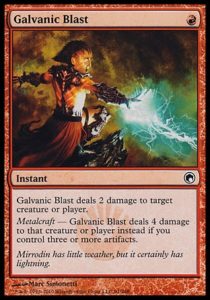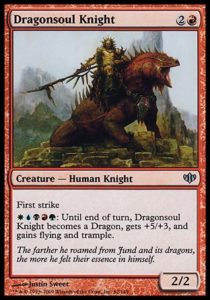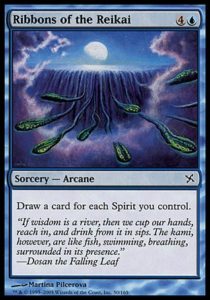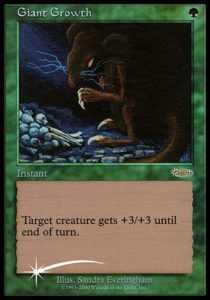This weekend, the wildest prerelease since ’95 is upon us: Iconic Masters will be unveiled at HasCon, and no one sitting down to play will have any idea what their sealed pools will contain. Moreover, yours truly will be among those people!
Obviously, I’m stoked to play this weekend. We’ve already taken a crack at what might be in Iconic Masters. Today, we’re going to go over something else: how to do a blind prerelease.
Obviously, this will be most relevant if you’re playing Iconic Masters this weekend, but it’s also relevant for any time you sit down to play with a new set. For example, if you don’t want to spoil yourself before a prerelease, haven’t researched every single card in a set, or are/know someone coming back from a hiatus.

Look for signposts
One of the main purposes of keywords and ability words is to communicate themes and archetypes to players. A card like Shock doesn’t tell you much (sure, the art and flavor text communicate the world). However, Galvanic Blast tells a whole story: there are a decent amount of artifacts in the set. This theme is prevalent enough that a keyword exists, so there must be more artifacts-matter cards (likely several with Metalcraft). Burning Vengeance, Thundercloud Shaman, and Dampen Thought all loudly broadcasted their themes in previous Masters sets. Even something like Grim Affliction, which doesn’t need any additional support, gives players more direction than a Splendid Agony. A Tome Scour gently suggests that there’s a mill theme, but Jace`s Phantasm both communicates the theme more loudly, as well as makes it clear who you’re supposed to be milling.
When you’re building a Sealed pool or making a pack one, pick one, take note of these signs. What keywords exist? What zones are you encouraged to care about? What colors do these cards appear in? Are there keywords or ability words* supporting these themes, or are they more loosely connected without a central mechanic? Also, take note of all multicolor cards—since Theros, Wizards has gotten very good at giving color pairs a powerful uncommon to communicate what their color is about, or at least reward one of that color pair’s subthemes.
* A minor aside for the sake of definition. The difference between keywords and ability words is subtle and doesn’t matter for the sake of play, but is good to know. Keywords, like Flying, Cycling, Embalm, Prowess, and Afflict are consistent (they work the same way every time, or have some internal knob like Afflict’s number to vary them) and can be referenced by other cards (like Astral Slide). Ability words, like Landfall, Metalcraft, Raid, Imprint, Converge, always appear in italics, don’t have to work the same way across cards, and can’t be referenced by other cards. Devotion is a keyword because it’s a consistent version of Chroma, which is an ability word. Neat, huh?
Don’t sweat the combat tricks
One of the common worries I hear about people going into unfamiliar formats is that they won’t know what tricks to play around. To them, I say that most people overestimate the value of combat tricks—sure, they’re good (particularly in formats with weak instant-speed removal), but playing around them isn’t going to prevent your opponent from having them. Oftentimes, people just take extra damage worrying about a combat trick that’s either going to happen eventually, or was never there in the first place. Additionally, the methods of playing around and into combat tricks are simple: either encourage it to happen on your terms and make the block (so that they’ve spent the combat trick when you go for a big double block) or have some instant speed removal to respond to their trick.
In a new format, most people haven’t memorized what every color’s tricks are, so they don’t know what to play around. This is compounded in a blind format—if you have no idea what to play around, then don’t play around anything in particular. If your opponent has one mana up, there’s not much they can represent and you should assume them have nothing, whereas if they have five mana up across three colors and four cards in hand, you should expect that some trickery is afoot (but it could be removal, pump, countermagic, a flash creature—the options are too myriad to plan a real countermaneuver).
My last advice is to not sweat ‘getting gotten’ by combat tricks. Blind events or semi-blind events like prereleases aren’t competitive events—they’re about having fun and exploring. If you get wrecked by a combat trick, then you’ve acquired knowledge for when competition starts and prizes and prestige are on the line.

When in doubt, default to aggro, skies, and goodstuff
I love chaos drafting (where you draft from a jumble of packs), and chaos drafts have little to no intended synergies (unlike a Masters format). You get a lot of cards that don’t function or are overcosted, because there just aren’t enough artifacts to achieve Metalcraft, Arcane cards, or discard outlets for Madness. In such formats, you can always pool cheap creatures into an aggro deck, combine fixing with your most powerful cards in goodstuff, or take advantage of folks’ slower and clunkier decks by abusing evasion (which is always good, but often falls behind in the cost/power ratio in synergy-heavy formats).
Now, I expect Iconic Masters to have plenty of synergies and intended archetypes, unlike chaos draft. However, if you’re stumped as to what you’re supposed to do, you can always default to these options. There’s only so much time in deckbuilding, and one can always default to tried-and-true strategies. Furthermore, Masters sets tend to be designed and developed with Draft, not Sealed in mind, so there’s a reasonable chance that your pool’s synergy just isn’t widespread enough, making building an aggro, tempo, or goodstuff control deck the best available option.

There’s my advice for blind prereleases. I hope to see some of you folks there (please, don’t hesitate to say hello!), either in person or in chat on Twitch. I’m deeply excited for this week, not only for the Iconic Masters prerelease, but also lots more news about Ixalan, Magic Arena, and the future of this wonderful game. Until next time, may all of your Diligent Farmhands correctly communicate that Muscle Burst is indeed in the format.
And, as always, thanks for reading.
—Zachary Barash
Zachary Barash is a New York City-based game designer. He works for Kingdom Death: Monster, has an MFA in Game Design from NYU, and does freelance game design.
His favorite card of the month is Censor. Every component of Censor is weak (neither U: Draw a card, nor two mana Force Spike for two mana is good), but put together it’s not only a formidable and flexible spell, it creates a powerful moment when you get someone with it. A Counterspell always hits its mark, but a Censor demands that you time it just right, that your opponent doesn’t see it coming or can’t help but play into it. And because actually countering a spell with it requires so much precision, the cycling cost is basically negligible, making it good (but rarely great) at every stage of the game. Compare it with the also-cool, bigger version in Countervailing Winds, which is also its own nifty design and another callback to powerful countermagic of old.


